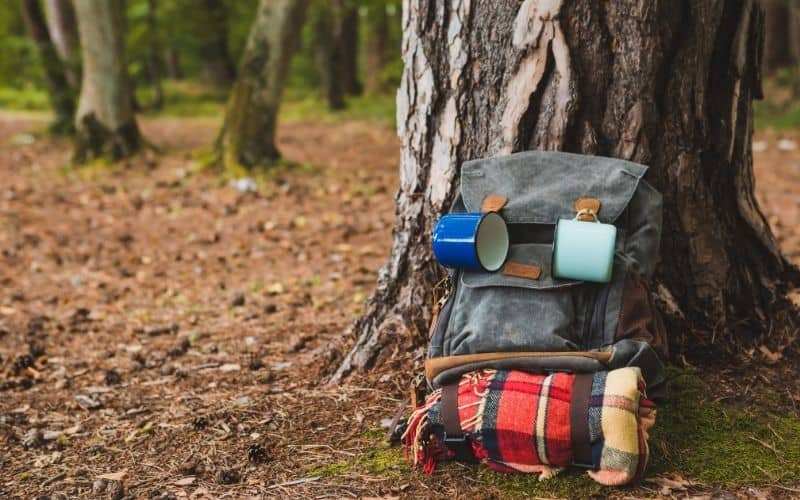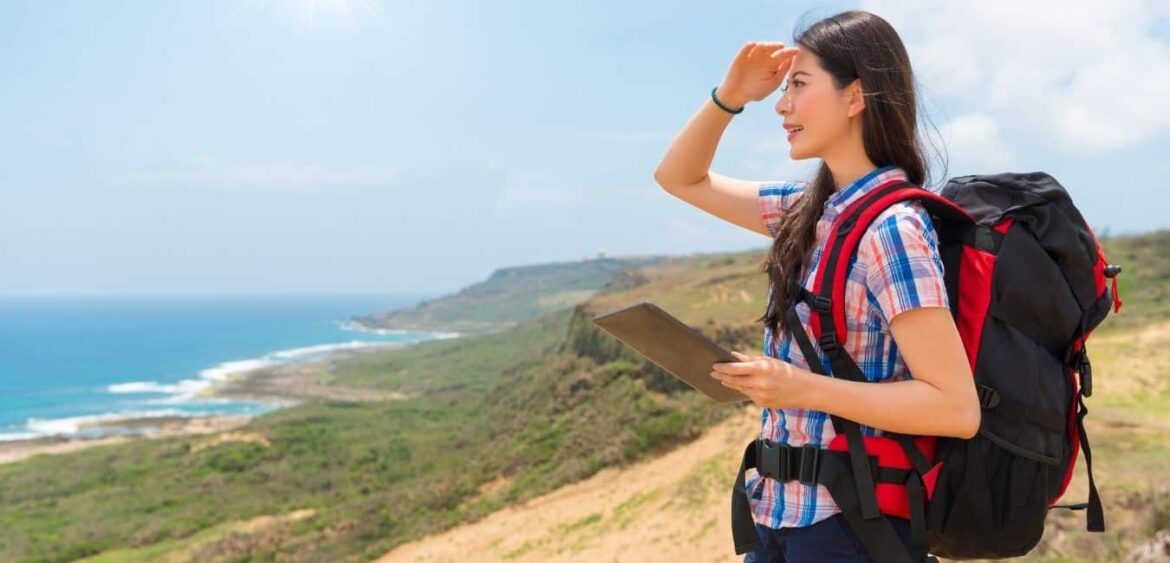Table of Contents
The Hike. Probably one of the most common tests of human endurance available.
When a person pits themselves against the spirit of the hill and proves that he or she can climb up any mound of dirt on Earth just to see the gleaming horizon stretching out to infinity.
Accomplishing this feat takes more than an indomitable will. It requires the right equipment.
Many great travelers have been lain low by carrying the wrong supplies in their undersized satchel or choosing a hiking backpack that chafed them raw, forcing them to throw it into a crevasse with foul curses.
Picking the best hiking backpack is about balance.
You need it to be big enough to take all the water, trail mix, and beer but not so large that it is cumbersome and weighs you down.
You want the proper straps and adjustments so that it is comfortable and fits you like a lumpy second skin.
You want something durable that can take a tumble down a glacial rockslide without tearing.
Most importantly, you want something that looks good because mountain goats are mean.
For all of this and more, we offer our 5 best-hiking backpacks.
COMPACT ASSAULT PACK
What’s to Love: Barb-wire tough.
What’s to Hate: Cramped quarters.
Hard-Core: It’s just cute as a button that you want to cart your energy bar up the hill.
When you’re ready to do something big-time, like pack some extra armor plates to raid an insurgent camp in a cave halfway up the mountain and need space for your sidearm, then you go to see Condor.
The Assault Pack is made with rough climbing in mind and won’t rip or tear under the most arduous of conditions.
It is relatively compact though it still manages to find space for a hydration bag and plenty of extra ammo.
The compact size is better for short trips or going up very serious gradients. If you plan on doing as much scrambling and climbing as hiking, this will help.
If you need extra storage for your makeup, this ain’t your bag.
Comes in small, medium, and large sizes depending on your mission outing and lots of lovely camo colors to complement your shoes.
More: Best Camping Gear
BLACK DIAMOND NITRO
What’s to Love: Hydration pocket.
What’s to Hate: Not very versatile.
Lighter Than Air: Weight is always a concern when it comes to hiking backpacks, and usually, the lighter ones are flimsy jobs that tear open like cheap grocery bags.
The Nitro isn’t like that. It does seem too light to be true at first, and you’ll be tempted to reinforce with something, like a military-issue duffel bag, but you must fight that urge.
The back is a unique ridged foam that offers airflow without sacrificing durability. The general size is good for day hikes and maybe overnight, though that would be pushing it.
It bears a separate hydration sleeve so bottles can be refilled without digging through your whole bag. The easy access top and mesh side pockets let you get what you need in a hurry. This makes hours on the trail a joy but turns days on the trail into hell on Earth.
More: Best Binoculars
Dakine Cyclone Ii Dry Pack 36l
What’s to Love: Compartmentalization.
What’s to Hate: Slower camera access.
Shutterbugs: Ansel Adams swears by this particular hiking backpack for photographers.
The truth is that if you are a serious photographer, few bags can both carry all of the lenses and equipment you need as well as provide sufficient space for silly things like water and food.
The Sequence’s interior compartments are made to let you carry everything for capturing the perfect shot of sunset over El Capitan.
At the same time, it can also be loaded with food and has a laptop compartment that can easily carry a camel bag for water.
The bad news is that it doesn’t have a separate fanny pack for your camera so quick-draw shots are often out of the question.
The good news is it doesn’t have a fanny pack to make you look like a tourist.
More: Best Camping Stoves
BERGHAUS Trailhead 65l Rucksack
What’s to Love: Reduced pack sweat.
What’s to Hate: Awful rain cover.
Total Comfort: Tall people, short people, hobbits, and hunchbacks all have trouble finding hiking backpacks to suit them.
Most designers start with average body types and don’t offer nearly enough options for those who need something different.
The Freeflow is made with the Biofit System, which changes the strap size and the overall length of the pack to help those whose bodies are made like special and unique snowflakes.
It is comfortable for almost anyone and includes an airflow system that helps keep your back cool, so you aren’t covered in what is scientifically known as “Back Pack Sweat.”
Tons of pockets and padding also make it easy to use and carry. The sole drawback is the included raingear is, how you say, terrible.
More: Best Hiking Boots
OSPREY EXOS 58
What’s to Love: Versatility.
What’s to Hate: The Price, oh Lord, the price.
Best All-Around: You can’t go too wrong with any member of the Osprey line, but the Exos 58 is the most impressive.
It is light enough to be used as just a hiking backpack for a day on the mountain yet sturdy enough to be part of a backpacking frame for a trek along the Pacific Crest Trail.
The ExoForm shoulder and waist straps stick tight without slipping and won’t dig into your body.
An AirSpeed back panel coupled with very light material help allows your back to breathe. It bears an integrated flap for rain and weather protection that works well.
It has pockets everywhere. There are a few on the waist strap, two mesh on the sides and one on the front, as well as zippered options all around.
You’ll even note an ice tool attachment on the side for alpine climbers and mountaineers. Includes removable compression and inside-out straps that allow it to transform into whatever you need in a pack.
More: Best Coolers
Skog Å Kust BackSåk Waterproof Floating Backpack
What’s to Love: Simple.
What’s to Hate: Very Simple.
Honorable Mention: TheSkog Å Kust BackSåk has many things to enjoy about it besides the name. It’s basically the modern version of the old-school rucksack you stuffed your younger brother into.
It is made of bomber 1200 D nylon treated with DWR (Durable Water Repellent), making it hard to get wet and hard to cut through. You should get years of use out of the TheSkog Å Kust BackSåk.
The compression straps are good for any load size, though you’ll find the pockets frustrating. It has one primary compartment with no specialized places, secret pockets, or high-tech nonsense.
If you like to throw a bunch of gear into a bag and get on the trail, the TheSkog Å Kust BackSåk is a fun – if not especially versatile – choice.
More: The Best Water Bottles
Buying Guide – Best Hiking Backpacks
There are many things to consider when buying a hiking backpack.
You need to balance comfort with weight, durability, and cost so that you can get the perfect pack for your journey.
Here are some tips on how to shop for a new backpack in order to sate your curiosity regarding these outdoor wonders:
Know Your Needs – While all backpacks come in a standard size, there is no such thing as a universal design. You have to find one that is right for your body type and your travel style.
Material
There are many options when it comes to the materials used in these packs. Still, nylon tends to be the most popular choice among hikers and adventurers. It is lightweight, durable, and versatile enough to handle what you need it to do while still looking good after long periods of use.
On the other hand, if you are an environmentalist, you might prefer a pack made from recycled materials.
Size
You must find a pack that fits you properly to keep you comfortable and safe during travel. If the pack is too small, then it may chafe or bounce as you walk. If it is too large, then it will make even simple tasks tedious and difficult, which can be dangerous in certain situations, such as scaling cliffs or crossing bridges made from rotting wood planks.
Pack Volume
You don’t want something too small because it will force you to leave behind what is important. You also don’t want something that is too large because more space means more weight which requires more effort to haul across deep ravines or through dense forests. If you are looking at packs that offer adjustable straps, then look into their minimum and maximum volume measurements. This will give you an idea of what kinds of loads they can carry before being readjusted.
Suspension System
The suspension system is what distributes the weight evenly throughout your body so that you can carry more than just your standard hiking bag. Look into the shoulder straps, sternum strap, hip belt, and load lifter straps to maintain comfort while out on extended trips.
Weight
A heavy hiking backpack can make even a simple hike feel like an impossible climb. You need to find one that is light enough to allow you to travel with ease but not so light that it feels flimsy or cheap. The weight of the backpack, along with its burden, should be evenly distributed across your body for maximum comfort.
Durability
You want strong and well-made things because being in the backcountry means dealing with nature in its rawest form. When you are surrounded by nothing but trees and wildlife, you have no protection from vines strangling your pack or any potentially hazardous object protruding out of the soil waiting for an unsuspecting traveler who isn’t watching where they are going.
Style
This is optional, but many hikers and adventurers like to be stylish while they explore. There are many different styles of backpacks available, so look around until you find one that suits not only your needs but your personality as well. In comparison, these backpacks come in an assortment of colors, designs, and materials. Strategic use of foliage can give your pack a more organic look. At the same time, dirt rubbed into the fabric will make it less shiny and reflective.
Organisation and Pack Accessibility
Having easy access to the contents of your pack is essential to both convenience and safety. If something leaks, breaks, or spills inside your pack, you will want easy access to it. Many external pockets allow you to organize the items that you frequently need into separate compartments so that they can be accessed easily without having to unpack every single thing in your bag.
Convenience
You don’t want a backpack that is too large because each additional liter of space means more weight, slowing down your pace and cause fatigue. If the pack is too small, it will limit what you can bring with you on your journey and make even simple tasks exhausting as you try to painstakingly sift through every item to find something as basic as a flashlight or first-aid kit.
Water Resistance
Having a pack that doesn’t allow water in is not only inconvenient but dangerous as well. Your clothes and any other belongings should be kept dry at all times if you want them to last because being damp for too long can cause mildew which spreads rapidly through fabrics causing rot and eventual ruin.
Padding for Added Comfort
Some backpacks have extra padding around the edges and in key areas of the pack to provide a comfortable rest for your body while you are traveling. If not, then consider purchasing a separate foam or inflatable pad that can be strapped down to the exterior of your bag to help alleviate some of the stress on your joints and muscles.
Accessories
The right accessories can make or break your journey, so try to get one that has compression straps, exterior pockets for easy access items like maps or snacks. It is also best to find one with ice ax loops for mountain climbing adventures or an external hydration pocket perfect for longer hikes where staying hydrated is key to survival.
Price
Like most things, it is possible to find hiking backpacks that come in all shapes and sizes when it comes to price range. It all depends on what kind of suspension system they have (or don’t have). Like the material used, the suspension system will make a difference when choosing something that suits your needs. You can get bags with adjustable straps for heavy loads. Still, there are also internal frames that offer more support but less flexibility in size. these high-end models can easily come close to matching the price of a typical trekking backpack, but you can find backpacks with quality suspension systems for less than $100

Frequently Asked Questions
What is the best hiking backpack?
The best one for you depends on where you are going, how long you are traveling for, how much gear you need to bring with you (sleeping bag, tent, etc.), what type of climate you will be traveling through (how well built your backpack needs to be), and how large you want your backpack to be.
What size backpack do I need?
This depends on the length of your journey, how much weight you need to carry, and what type of space you will have access to at different points along the way. If you can’t estimate these variables, then it is always better to get a larger backpack rather than a smaller one, as this gives you more freedom to make adjustments should circumstances change.
How often should I replace my hiking backpack?
Your hiking backpack should last for several years if it is well-made and not overloaded with unnecessary items that will weigh down its structure and cause irreparable damage. If there are tears or obvious signs of wear, then it might be time to replace your bag before something happens that could compromise your health.
What is the best hiking backpack material?
The best backpack material depends on your situation, where you are going, what kind of environment you will be traveling through and what type of weather you are most likely to encounter. If you can’t answer these questions, it is typically better to go with a more durable fabric like ripstop nylon or ballistic nylon. This is designed to withstand wear and tear that is often unavoidable when hiking.
What makes a good hiking backpack??
The best hiking backpack is one that has all of the features you are looking for, with space to fit everything inside. It should have a good warranty and be easy to clean. It lasts as long as possible without deteriorating or showing excessive wear and tear. A good pack also needs appropriate straps that distribute weight evenly across your body so that carrying it becomes natural instead of exhausting.
How do you break in a hiking backpack?
A hiking backpack should be easy to break in without causing pain or discomfort. However, find that the straps are digging into your shoulders. It might be a sign that you need to adjust it as some backpacks can fit differently from person to person. Ensure there is plenty of padding so that the weight is evenly distributed. Try not to overload it with too many unnecessary items as this will cause an imbalance that will make it difficult for you to carry.
How do I test a hiking backpack?
It’s simple: just load up your pack with heavy items and pick a spot outside where you can walk around for 20-30 minutes while wearing the bag on your back. This is important because you want to see how well the bag is distributed across your body and whether or not you are experiencing any chafing, rubbing, or discomfort. If the bag isn’t adjusted correctly, then it will be difficult to carry or might cause you to stagger around like a drunk person – this is bad news.
How do I care for my hiking backpack?
You should always try to keep your pack clean by regularly wiping it down with a damp cloth. It’s also important that you never overload your pack so that weight can be evenly distributed over the entire surface area of the bag rather than one place where it could potentially cause damage or tear an existing hole in your backpack. Most importantly, remember that only light items should go inside the main storage compartment as heavier objects should be attached to the outside of the pack in order to maintain good balance.
Conclusion
If you are headed out on a long hike, then it is always best to be prepared with the right equipment, and that includes making sure your hiking backpack fits properly and has all of the features you need. With this advice in mind, you will be ready to take on any hike with confidence.

